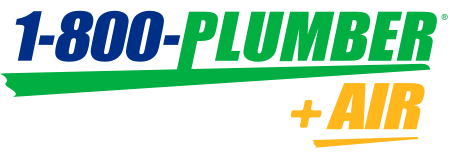The more you understand about your home’s plumbing, the better your position is when something goes wrong—and there’s nothing more alarming than a mysterious problem with your home’s drainage. When your drain clogs or backs up, or when your home’s main drain line develops a crack that fills up with tree roots, the plumbing team at 1-800-Plumber +Air wants you to know what’s going on and what steps need to happen next. Whether you’re searching for answers about main line plumbing because you’ve just bought a new home or because you’re in the middle of a main sewer line emergency, use this quick overview of main drain lines to get started.
What’s a Drain Line?
Home drains are the small pipes that run from every toilet, sink and shower drain, and drainage tube from appliances to carry waste water out and away from your home. These individual drain lines all connect to the main home drain line, or the main line, which runs from your home to the municipal sewage system along your street.
All of these lines are interconnected, but it’s important to clearly understand the differences. As a broad overview, think of drains as all the small pipes that run through your home’s floors and foundation. The main line is what your home’s drains empty into, and the main line shunts all the waste and water to treatment plants or septic systems.
The Importance of a Drain Line
Your drain line’s most important role is to get rid of waste and wastewater so it doesn’t build up on your property. If the drain line gets clogged or obstructed, sewage will back up into your home, and because it’s the main line, those overflows can back up into any drain in your home. If the main line cracks because of ground pressure or because of old cast iron materials giving way, sewage can slowly seep into the ground. Thirsty tree roots will also grow towards the crack, where they will make the crack bigger and clog up the pipe.
Because of these risks, it’s important to conduct routine servicing and maintenance of your drain line.
Important Maintenance to Do on a Drain Line
Your home’s smaller drains require maintenance, it can be a mix of DIY to-dos or professional services, depending on your comfort level. Carefully clearing away clogs, using filters and baskets to prevent clogs in the first place, and checking your drains for sounds and smells that indicate a clog are all important maintenance tasks to frequently perform.
But a drain line is different; main drains require professional maintenance and main line plumbing services because the pipe is so far underground. Some of the important maintenance tasks for preserving your main line in good condition are:
-
Having the line scoped and inspected if you have recurring clogs and overflows: A plumber can insert a camera on a scope to look for clogs, tree roots, and cracks.
-
Removing clogs: Professional plumbers can use cutting tools such as a water jet cutter to cut free clogs and buildup
-
Relining cracked pipes: For minor to moderate damage, plumbers can insert a new lining to cover the interior of the pipe.
-
Replacing main lines: For significant damage, such as large cracks, pipe deterioration, and severed pipe connections, plumbers can dig up the affected sections or the entire drain line and replace it.
Choose 1-800-Plumber +Air for Drain Line Maintenance and Repairs
Your home has several drains and a main drain line, and they all work together to keep your home safe from waste and water. If your drains aren’t working properly, reach out to 1-800-Plumber +Air, and a local plumbing team will be able to assist you.
Image Credit: Steve Cukrov / Shutterstock
